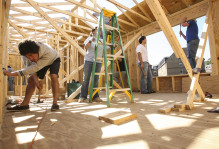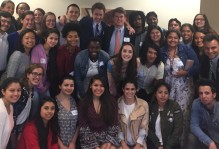Food for Thought
“In retrospect, it wasn’t the best idea to put Washington in the title,” our speaker told us last Friday. John Williamson, an economist, had come to our class to discuss the Washington Consensus, a term he coined in a very influential piece he wrote about economic and political development. Williamson was blunt about both the successes and failures of his work, but he also made it clear that it probably was not in his best interests to name his piece “the Washington Consensus” given the low opinion associated with certain parts of the city these days. Dysfunction in the nation’s capital is old news at this point, but not every part of Washington is gripped by gridlock. Recently, myself and some other DC scholars were able to get a glimpse of an organization that is working to make a difference, a part of Washington that works.
Folks at William & Mary tend to be a service minded bunch. Whether we tutor kids, volunteer at Campus Kitchens, or help feed the homeless, back on campus, many of us DC Scholars are involved with numerous organizations dedicated to helping others. This past weekend, we had the chance to help aid one of the many groups in DC that’s dedicated to making the city a better place. The Capital Area Food Bank is an organization dedicated to helping those who suffer from hunger have nutritious meals. Their ultimate goal is to end hunger in Washington DC, a daunting task, but one that the group is not afraid to tackle. According to its website, the organization, “annually distributes 45 million pounds of food, equivalent to 37.5 million meals.” Two Saturdays ago, we played a small part in helping provide some of those meals.
 Arriving near a local library, not terribly far away from the US Capitol building, we were greeted to the site of a few trucks and many committed volunteers. Following a quick explanation about the procedure for the morning, everyone went to work setting up the market. After putting up several tents (which brought back a lot of memories of raising the team tent back in high school cross country), we began unpacking the food, mostly fresh vegetables and chicken. The Capital Area Food Bank also pushes sustainability, so any damaged items we found were set aside to be donated to local farmers, with the goal being that no food went to waste. At the tent next to us, a member of the food bank had set up a cooking station, where she ran demonstrations showing how to make delicious, nutritious meals out of the items found at the market. Soon it was time for the market to open. After registering, people could come in and pick out the items they needed. Within 3 hours, my station went through over 30 boxes of collard greens (at least). By the time the market closed, the vegetables were all gone. When all the food had been given away, we took the tents down and ensured that they were packed up for next time.
Arriving near a local library, not terribly far away from the US Capitol building, we were greeted to the site of a few trucks and many committed volunteers. Following a quick explanation about the procedure for the morning, everyone went to work setting up the market. After putting up several tents (which brought back a lot of memories of raising the team tent back in high school cross country), we began unpacking the food, mostly fresh vegetables and chicken. The Capital Area Food Bank also pushes sustainability, so any damaged items we found were set aside to be donated to local farmers, with the goal being that no food went to waste. At the tent next to us, a member of the food bank had set up a cooking station, where she ran demonstrations showing how to make delicious, nutritious meals out of the items found at the market. Soon it was time for the market to open. After registering, people could come in and pick out the items they needed. Within 3 hours, my station went through over 30 boxes of collard greens (at least). By the time the market closed, the vegetables were all gone. When all the food had been given away, we took the tents down and ensured that they were packed up for next time.
It’s easy in today’s world to become cynical or pessimistic about the future, but for all the poverty, hunger, or other issues facing society there are legions of committed people attempting to solve these problems and find lasting solutions. I’m not saying that Mr. Williamson should have named his piece, “The Capital Area Food Bank Consensus,” but the organization does represent a good example of people working together to bring about positive change and take a bite out of hunger (get it?). The dedication and commitment of the folks involved with the Capital Area Food Bank was (to borrow a phrase from President Reveley) “marvelous” to behold. The other scholars and I were glad of the opportunity to help out, even if it was just for one day. In the shadow of the US Capitol, we got to see a part of Washington that works, a group dedicated to facing challenges, helping others, and finding solutions. While the Capital Area Food Bank might not have ended hunger on that October morning, they nevertheless helped make things a little brighter for the DC community.




No comments.
Comments are currently closed. Comments are closed on all posts older than one year, and for those in our archive.